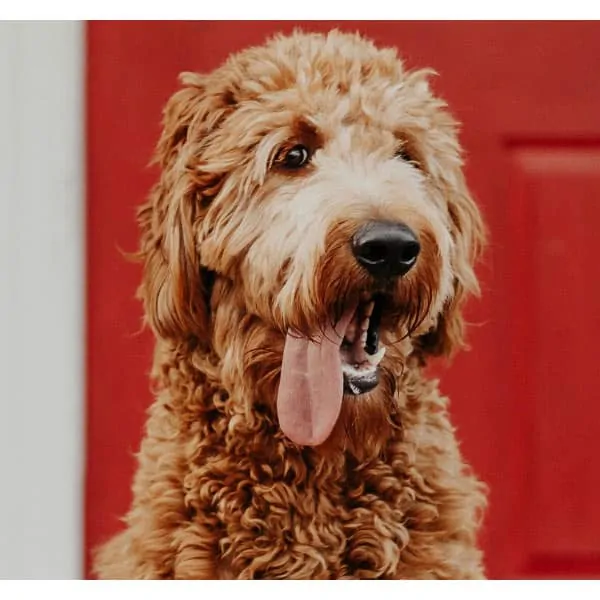Goldendoodle Training Tips – Complete Timeline for training a Goldendoodle
Getting an adorable, new puppy is fun and exciting for the whole family. Unfortunately, it can also be overwhelming without research, careful planning, and patience.
With this guide, you’ll be able to experience how rewarding it is to own a puppy, especially a Goldendoodle.
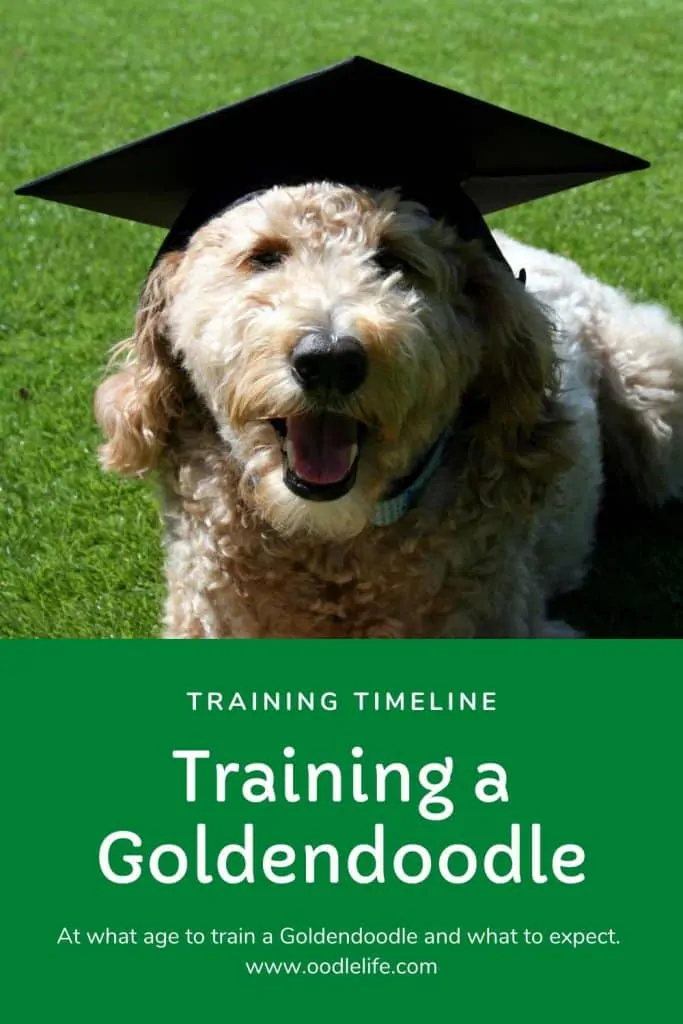
We’ll teach you the timeline for training and socializing your new furry friend and give specific Goldendoodle training tips. Soon, you’ll be ready to show the world your well-behaved Goldendoodle!
Goldendoodle Training Tips
The key to enjoying your dog is to train them early or as soon as possible. After all, training your new puppy in socialization is part of their essential needs. Training your dog is a big undertaking, though. One that may seem daunting.
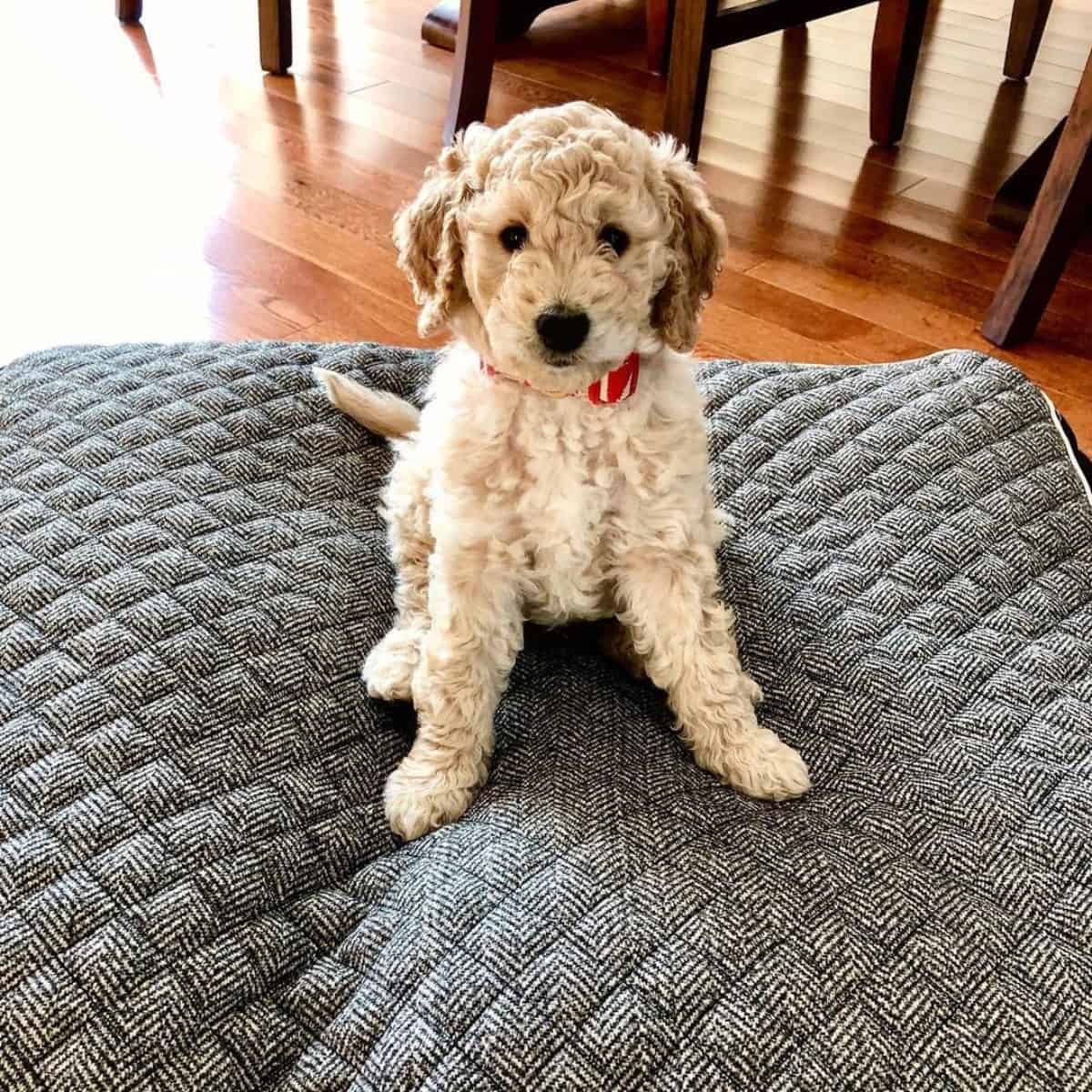
Rest assured, though, you can do it yourself without expensive obedience classes. The first thing you need to do is build a strong foundation for training.
Goldendoodle Training Timeline Infographic
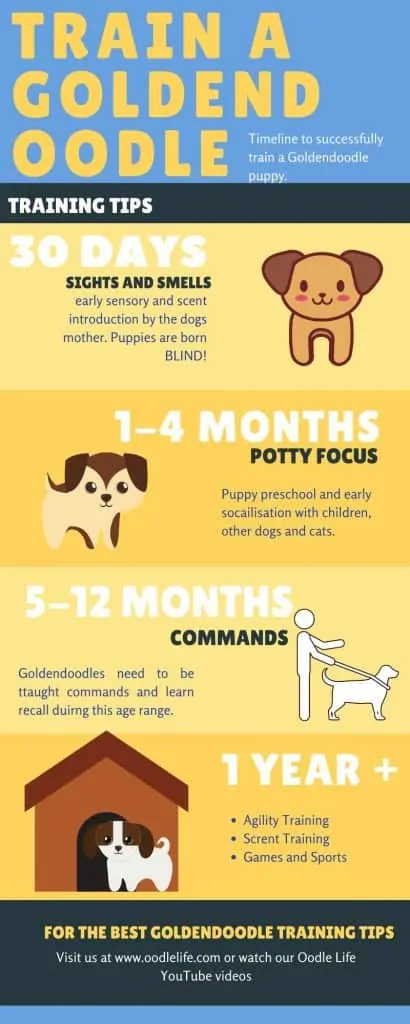
Goldendoodle Puppy Training at Home (First 30 days)
Puppies are born blind and deaf and cannot see or hear for the first ten to twenty days.
However, they have a fantastic scent and touch abilities. Puppies are also aware of the temperature. early training is usually done by the mother of the puppy. If the mother is unavailable, humans can step in to help.
Training sessions for newborns are short and to the point. These sessions consist of Bio-Sensor training, where they are stimulated with swabs like Q-Tips.
Exercises can be performed along with exposing them to minor temperature changes. This will stimulate the brain and help them deal with stress.
Mother dogs stimulate the senses from birth by licking and cleaning the puppies. This helps them develop.
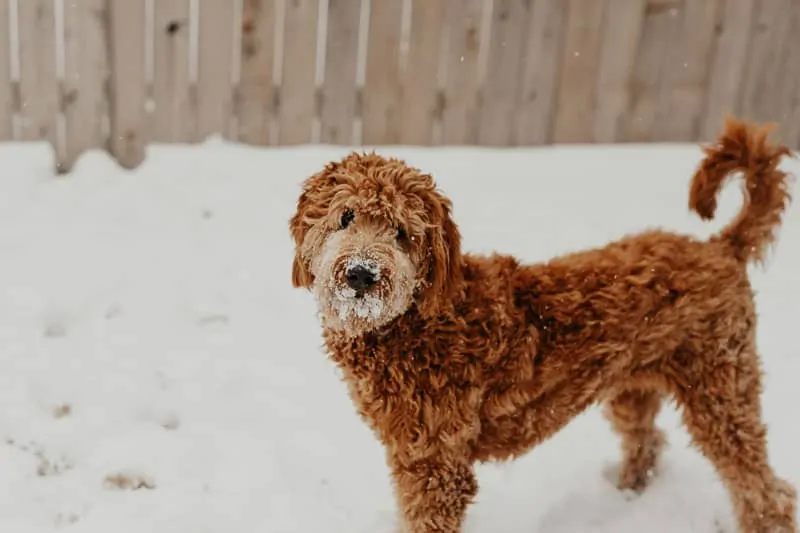
Early Scent Introduction, or ESI, will also start now. Since dogs have scent receptors twenty-five times better than ours, they can smell things several hundred feet away. You should expose them to calming scents and daily scents of rain, grass, and other things outdoors.
Then, their ears will open, and they will need to be introduced to sound. Dogs learn by association, so only play soothing sounds.
This is when you should introduce blind noises or background noise we don’t pay attention to, like the refrigerator running, a clock ticking or breathing.
As their eyes start to focus, you should start with colors. Show them colors on the spectrum they’re able to see by giving them objects they can play with. This will help build confidence.
Goldendoodle Puppy Preschool and Earliest Socialization (1-4 months of age)
At around three months of age, your Goldendoodle is full of energy and ready to play. But remember that they are still a baby – just an infant animal. It is so essential you practice positive reinforcement with your puppy and avoid punishment altogether.
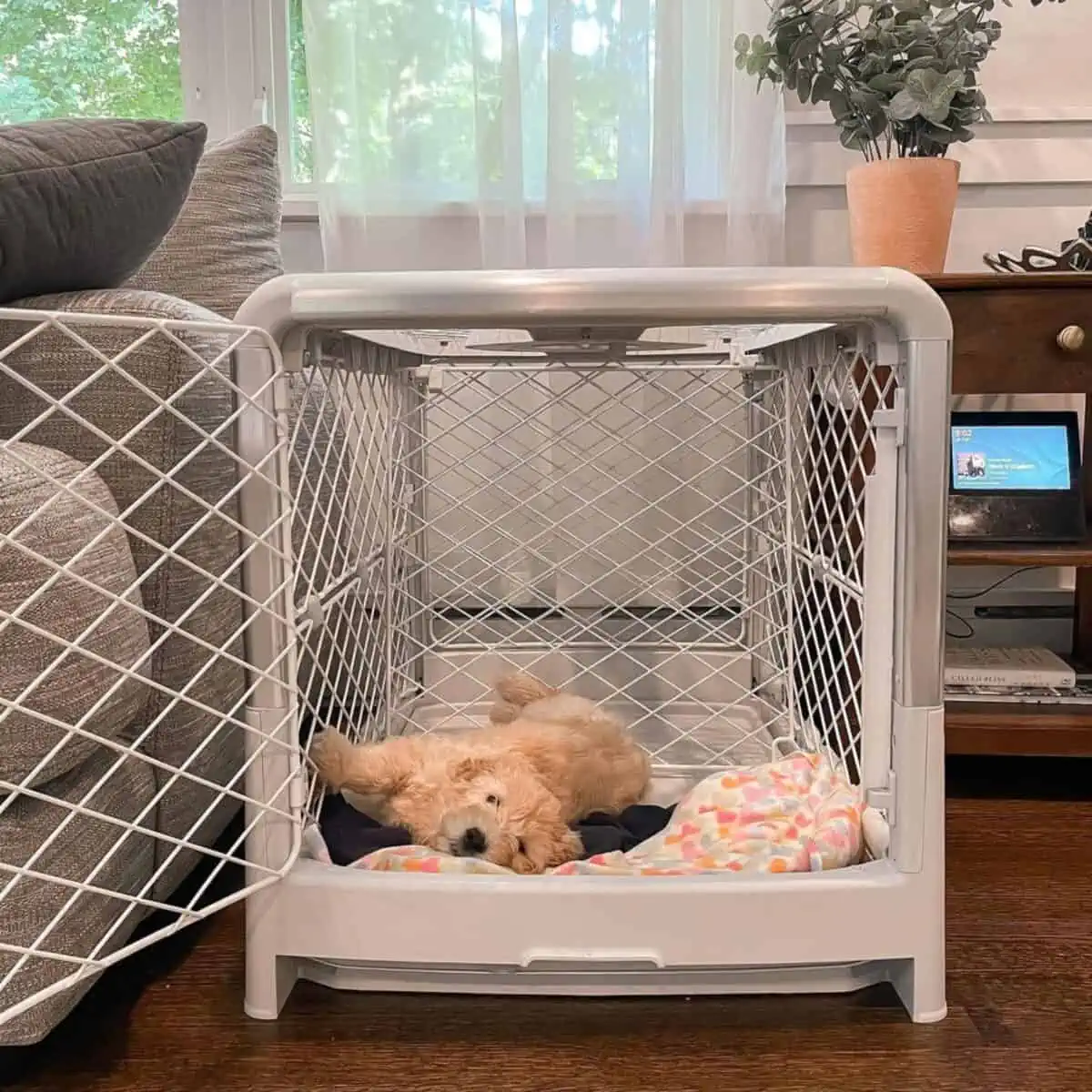
This is also the age your Goldendoodle is ready to learn basic commands.
The first thing you should do is pick a definite marker. A positive marker is a word, sound, or phrase used to tell your dog they have done something right. Common markers are “good, boy,” “good, girl,” or “yes.”
It can also simply be the click of a training clicker. Use the same marker every time.
Also, you should follow it up with positive reinforcement in the form of a treat, playtime, or affection.
Reward your puppy often and early, so they associate the treat with the behavior. Then, they’ll start doing the command without you asking.
Negative reinforcement or punishment will likely do nothing but scare your puppy. Puppies will chew things and have accidents in the house. However, you should remember they are still learning, and any punishment is counterproductive.
Simply correct the mistake and praise them when they do something right. The most important thing is to be consistent. Your puppy learns by doing, and repetition is the best thing for them.
This is also the age where socialization is a critical part of their development. In fact, it should be part of the puppy’s daily routine. All this begins once the Goldendoodle has the all-clear from the Veterinarian to socialize in public..
During this age, your Goldendoodle should be exposed to new people, places, and animals every day. If your puppy shows fear or anxiety, take a step back. This is when you should begin doing gradual exposure.
- An early introduction to children, toddlers, and babies make this much easier
- Safe introduction to different sizes and temperament dogs is important early
- If you introduce a dog to a household with cats, extra care needs to be taken early to ensure a long-term relationship of tolerance.
Goldendoodle Training for Safety and Basic Commands (3 months to one year)
At around four months old, your puppy will begin to develop preferences. Your job is to make them feel safe and secure in any environment.
This way, your puppy will grow up to be confident, kind, and ready to take on anything. Positive reinforcement techniques are especially important during this stage.
Any harsh punishment can have adverse effects on the Goldendoodles psyche.
Since your puppy has had all his shots, they are ready to go to the dog park, daycare, and puppy training classes. This will help with socialization.
Keep in mind that forcing your puppy to interact with others can hurt the bond you have with them. Always make sure your dog is enjoying the experience and is safe. Allow him to explore the world at his own pace.
This I the time to start introducing your Goldendoodle to water. Early and frequently exposure will make taking your Goldendoodle to the pool or even the beach a breeze.
Learning Commands
Additionally, this is when puppies can begin learning commands like sit and stay. Teach them to sit before exiting with treats. Lure them into a sit by the door and begin to open it.
If they get up too quickly, close the door. Keep up this game until the dog remains seated and patiently waits for the door. When they do, give them a treat.
Most puppies are highly motivated by treats and food. If they anxiously await each meal or immediately pounce on the food bowl when it is set down, this is an excellent opportunity to work on self-control.
Before every meal, have your Goldendoodle wait to eat. Place the food down and say stay. If they lunge for the bowl, take it away for five minutes. Start with a five-second wait and gradually increase it by five-second increments. This will allow their self-control to get better.
Another great Goldendoodle training tip is the Four on the Floor for those puppies that jump on anyone entering your home. Practicing this technique can stop the puppy from jumping up on unsuspecting bystanders and knocking over kids.
When you come home, and your Goldendoodle is happy to see you, make him sit before saying hello. Give an ear rub or greeting only when all four paws are on the ground.
Training a Goldendoodle to Enjoy Grooming (All ages)
Start grooming your puppy at a young age and practice handling with this Goldendoodle training tips:
- Work when your puppy is relaxed and not hyper.
- Keep grooming sessions short like a few brush strokes or clipping a few toenails.
- Use a quality slicker brush that will not hurt your Goldendoodle
- Practice frequently, like weekly.
- Pair it with a treat.
- Lightly touch-sensitive spots like between the paws or on the ears from an early age
- Use only Goldendoodle appropriate shampoos
Consider buying a grooming table early so your Goldendoodle can get used to it if you are going to be DIY grooming your Goldendoodle at home. See the best grooming tables specifically for Goldendoodles.
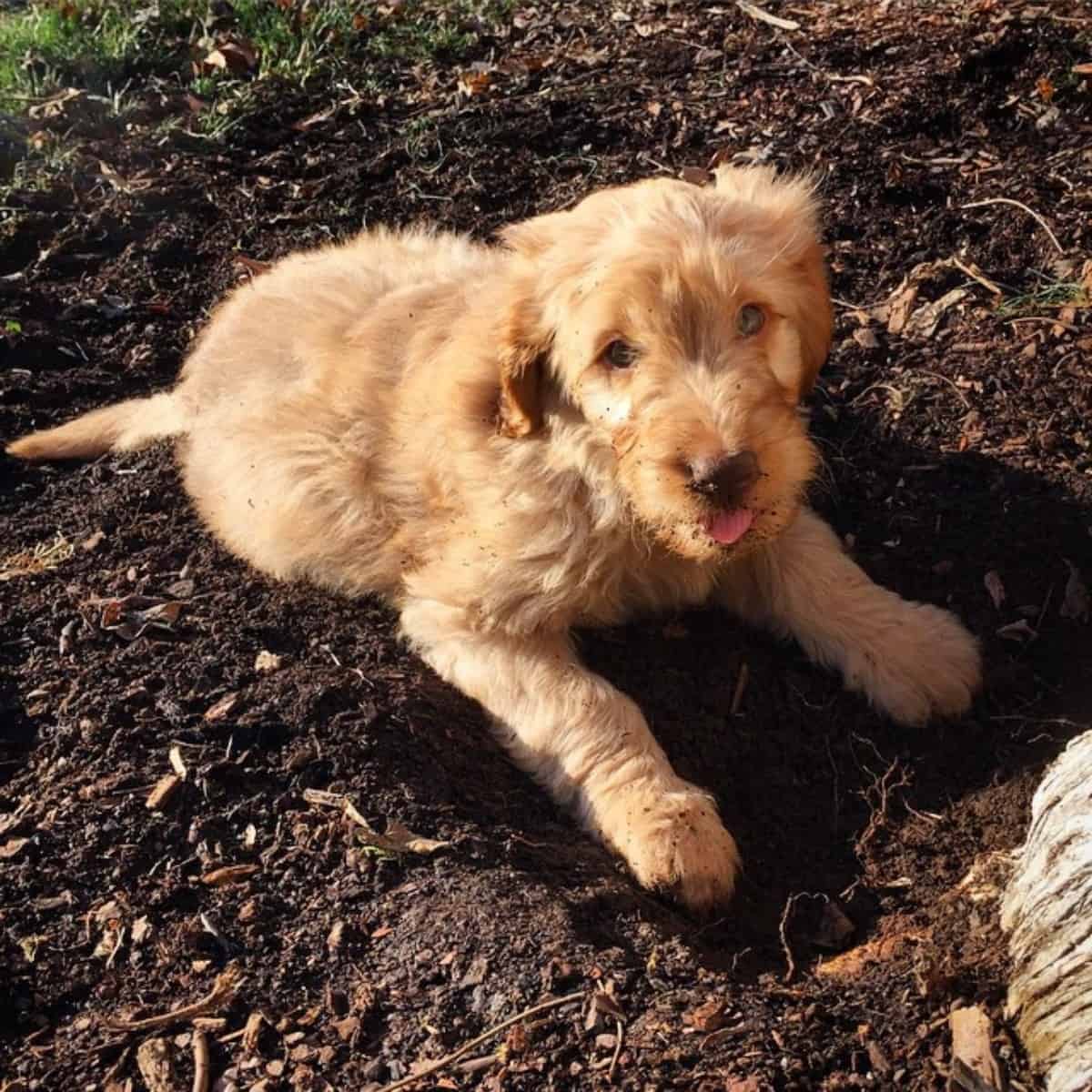
Advanced Goldendoodle Training Options (12 months plus, agility, and advanced classes)
The American Kennel Club, or AKC, says that once dogs learn basic commands, they can move on to advanced training or sports. You may opt to teach them scent training.
Treibball, a German dog sport not just for herding breeds, is when the dog drives eight oversized inflatable balls into a goal. They can also do obstacle courses and test their agility.
Scent training is also a fantastic way to mentally enrich your dog and stimulate their brain daily. Scent training starts as simple as a muffin tin game at home. Then advanced courses do wonders and can result in some very complicated tricks and habits forming.
What is a Goldendoodle? (Background the influences training)
A Goldendoodle (or Groodle) is a cross-breed of a Golden Retriever and Poodle. The Goldendoodle is a “designer” mix that was originally bred in the 1960s to be a guide dog.
While they vary in size depending on their parents (since Poodles range from mini to medium), they almost always have hypoallergenic hair and rarely shed. You can see which types of Goldendoodle shed the least in our Goldendoodle Coat Prediction article.
Goldendoodles are highly intelligent and lovable dogs that are ideal for families with children or other pets.
Goldendoodles typically weigh anywhere from forty-five to 100 pounds. Still, they can weigh as little as fifteen pounds if a parent was a miniature Poodle. The smallest Goldendoodles are Teacup and Toy Goldendoodles. They have a height of thirteen to twenty-six inches with a curly coat in red, black, gold, cream, brown, white, or grey.
Goldendoodles are very friendly, affectionate, playful, and trainable. They don’t need tons of exercise, they don’t bark often, and they don’t shed much.
Goldendoodles became popular in the 1990s for their hypoallergenic, non-shedding Poodle-like fur and having the temperament of a Golden Retriever, the most popular dog breed in the U.S.
The idea to breed the Poodle and Golden Retriever came from the Labrador and Poodle’s successful breeding to make the Labradoodle.
They have been used as pets, agility dogs, therapy dogs, guide dogs, diabetic dogs, and search and rescue dogs.
Goldendoodles are in the top five of the 150 smartest dog breeds. When you choose a Goldendoodle, rest assured you are getting an intelligent, athletic, loving companion, the whole family can enjoy.
